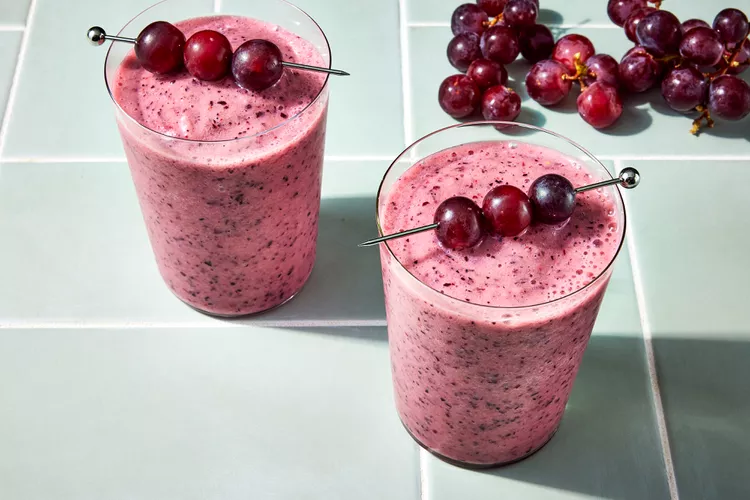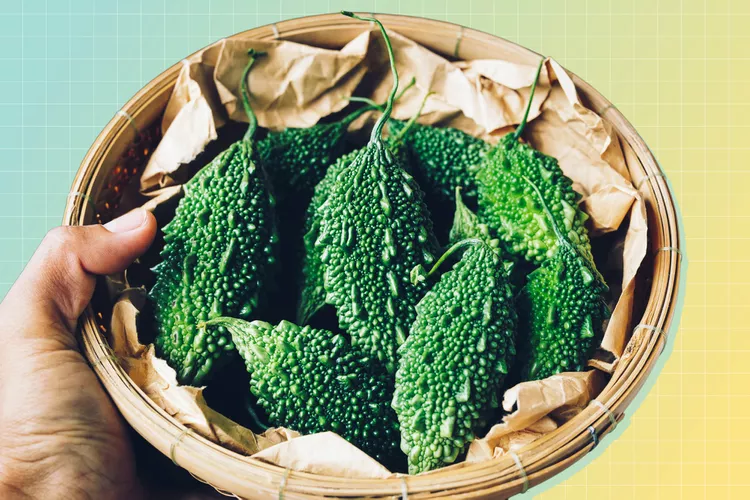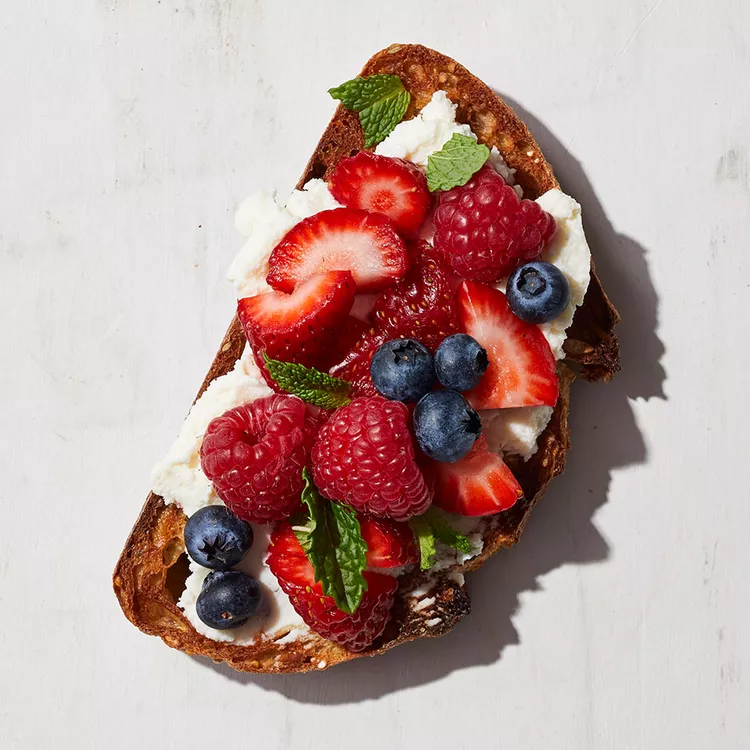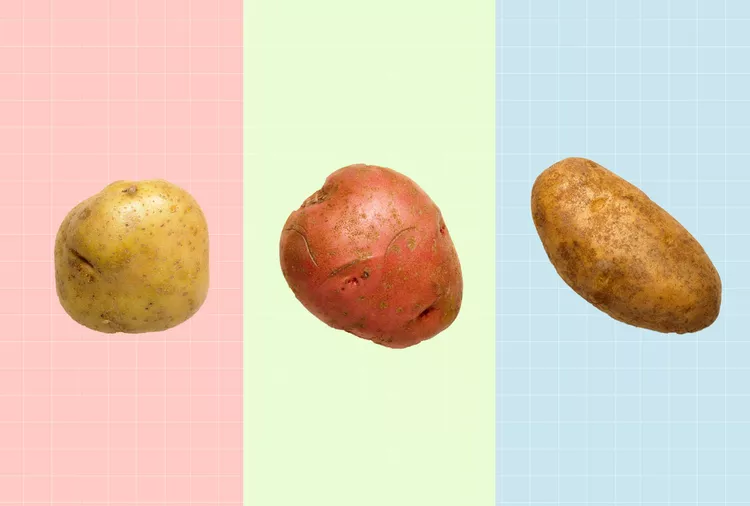Contents
A Guide to Popular Rolls and Healthier Choices
Sushi Calories: What You Need to Know Before Your Next Bite
California Roll Calories: Sushi, a beloved Japanese dish, has gained immense popularity worldwide, including in the United States. Typically served in roll form, a sushi roll consists of 6–8 pieces made with a combination of seafood, vegetables, and rice, all wrapped in nori (dried seaweed). Depending on the ingredients, 2–3 pieces of sushi contain anywhere from 93 to 190 calories.
While sushi is often considered a healthy and weight-loss-friendly food, appearances can be deceiving. The calorie and sodium content can quickly add up, especially in rolls with rich sauces, fried components, or larger rice portions.
This guide breaks down the calorie content of popular sushi styles, including sushi rolls, sashimi, and nigiri, helping you make informed choices that align with your health and fitness goals. By understanding what’s in your sushi, you can enjoy this delicious dish while staying mindful of your dietary needs.
Popular rolls
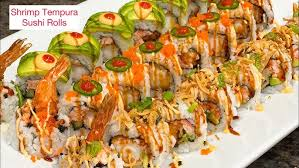
California Rolls: A Safe and Tasty Sushi Option
The California roll is one of the most popular types of sushi, made with a combination of cucumber, avocado, and imitation crab, all wrapped in nori (dried seaweed). Also known as surimi, imitation crab is made from pollock, a fish known for its low mercury levels, making the California roll a safe sushi option for pregnant women looking to enjoy sushi. This roll is also ideal for those who are cautious about raw fish, as imitation crab is precooked.
On average, 2–3 pieces (100 grams) of a California roll contain:
• Calories: 93
• Protein: 2.9 grams
• Carbs: 18.4 grams
• Fat: 0.7 grams
• Sodium: 428 mg (about 18% of the Daily Value)
Spicy Tuna and Salmon Rolls: Flavorful and Rich in Protein
Spicy tuna and salmon rolls are made with vinegar-seasoned white rice, avocado, cucumber, sesame seeds, and a spicy chili sauce that gives these rolls a bold flavor. These rolls include either raw tuna or salmon, both of which are commonly known as sashimi in Japanese cuisine.
For spicy tuna rolls, 2-3 pieces (100 grams) contain:
• Calories: 175
• Protein: 7.5 grams
• Carbs: 16.7 grams
• Fat: 7.5 grams
• Sodium: 217 mg (9% of the Daily Value)
For spicy salmon rolls, 2-3 pieces (100 grams) contain:
• Calories: 190
• Protein: 6 grams
• Carbs: 24 grams
• Fat: 6 grams
• Sodium: 330 mg (13.6% of the Daily Value)
Both rolls offer a delicious, protein-packed option, though they are slightly higher in calories and sodium compared to simpler rolls like the California roll.
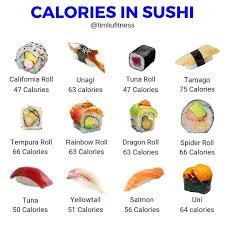
Shrimp tempura roll
Tempura Roll: Crispy, Flavorful, and Delicious
Tempura is a Japanese cooking technique where seafood, meat, or vegetables are lightly battered and deep-fried. For the shrimp tempura roll, shrimp is coated in a mixture of flour, eggs, and breadcrumbs, deep-fried to a crispy golden texture, and served with a savory tempura sauce made from soy sauce, sugar, and mirin, a type of rice wine. If you prefer cooked seafood over raw or enjoy a crispy texture, the shrimp tempura roll is a fantastic choice.
Two to three pieces (100 grams) of shrimp tempura roll provide:
• Calories: 175
• Protein: 3.7 grams
• Carbs: 28 grams
• Fat: 5.9 grams
• Sodium: 421 mg (17% of the Daily Value)
Avocado Roll: A Fresh and Light Vegetarian Option
While sushi is often associated with raw fish, there are plenty of delicious vegetarian options available. The avocado roll is a popular choice, featuring avocado, pickled ginger, sesame seeds, and a spicy dollop of wasabi wrapped in nori (seaweed). It’s a healthy, plant-based sushi option that’s full of flavor without any fish.
Two to three pieces (100 grams) of avocado roll contain:
• Calories: 140
• Protein: 2 grams
• Carbs: 24.8 grams
• Fat: 3.7 grams
• Sodium: 483 mg (20% of the Daily Value)
Rainbow Roll: A Bold and Colorful Sushi Creation
For a more adventurous sushi experience, the rainbow roll combines imitation crab with a variety of raw seafood, such as tuna, salmon, tilapia, and shrimp. Along with avocado, cucumber, mayonnaise, and sesame seeds, this roll offers a vibrant and colorful array of flavors. It is wrapped in nori and typically served with wasabi, pickled ginger, and soy sauce.
Two to three pieces (100 grams) of rainbow roll provide:
• Calories: 146
• Protein: 7.3 grams
• Carbs: 17 grams
• Fat: 5.7 grams
• Sodium: 301 mg (12.5% of the Daily Value)
The rainbow roll is perfect for those who love variety and bold flavors, offering a satisfying and nutrient-rich meal.
Philadelphia roll
Philadelphia Roll: A Creamy and Flavorful Sushi Delight
The Philadelphia roll is a unique and flavorful sushi variety that combines smoked salmon, cream cheese, dill, sesame seeds, pretzel salt, and cucumber. This roll brings together a delicious mix of creamy textures with the smokiness of salmon for a satisfying sushi experience.
Two to three pieces (100 grams) of Philadelphia roll contain:
• Calories: 170
• Protein: 7 grams
• Carbs: 20.5 grams
• Fat: 6.5 grams
• Sodium: 285 mg (12% of the Daily Value)
Salmon Avocado Roll: Fresh, Nutritious, and Full of Flavor
The salmon avocado roll is a popular choice for sushi lovers, featuring raw salmon paired with mashed avocado, white rice, and a variety of toppings such as pickled ginger, sesame seeds, and seaweed. This roll offers a fresh and creamy taste, making it an ideal option for those who enjoy healthy fats and lean protein.
Two to three pieces (100 grams) of salmon avocado roll provide:
• Calories: 179
• Protein: 5.8 grams
• Carbs: 30 grams
• Fat: 4.6 grams
• Sodium: 357 mg (15% of the Daily Value)
Dragon Roll: A Bold and Flavorful Sushi Experience
The dragon roll offers a variety of options, including vegetarian versions and those made with eel. The roll often includes ingredients such as imitation crab, tempura shrimp, avocado, cucumber, and a rich unagi sauce made from soy sauce, sugar, and caramel color. Depending on whether you choose a prepackaged version or freshly made sushi from a restaurant, the ingredients and calories may vary.
For prepackaged dragon roll sushi with eel and imitation crab, two to three pieces (100 grams) typically contain:
• Calories: 175
• Protein: 4.8 grams
• Carbs: 20.6 grams
• Fat: 7.9 grams
• Sodium: 397 mg (16.5% of the Daily Value)
The dragon roll is perfect for those who enjoy rich flavors and a satisfying balance of protein and healthy fats, making it an excellent choice for your next sushi meal.
Cucumber roll
Cucumber Roll: A Light and Refreshing Sushi Option
The cucumber sushi roll is a light and refreshing choice, typically made with raw tuna, imitation crab, avocado, and radish sprouts. This roll is enhanced with a variety of flavorful sauces, including spicy chili sauce, gobo sauce (a blend of burdock and soy sauce), and ponzu sauce (a citrus-infused soy sauce). These ingredients come together to create a satisfying sushi experience with a balance of crunchy, creamy, and spicy flavors.
Two to three pieces (100 grams) of cucumber roll contain:
• Calories: 78
• Protein: 4 grams
• Carbs: 5 grams
• Fat: 5 grams
• Sodium: 319 mg (13.3% of the Daily Value)
Spider Roll: A Crispy and Spicy Sushi Delight
The spider roll is a popular cooked sushi option, made with tempura soft-shell crab, spicy mayonnaise, vinegared rice, and nori seaweed. The crispy texture of the tempura crab combines beautifully with the rich, spicy mayo for a sushi roll that’s both satisfying and bold. Perfect for those who enjoy a crunchy and flavorful sushi experience.
Half a spider roll (around 100 grams) contains:
• Calories: 214
• Protein: 6.5 grams
• Carbs: 16.5 grams
• Fat: 13.5 grams
• Sodium: 373 mg (16% of the Daily Value)
The spider roll is ideal for sushi lovers who prefer cooked seafood and enjoy a bit of heat with their sushi experience.
Sashimi and nigiri
Sashimi: A Low-Calorie, Pure Sushi Experience
Sashimi is a unique, rice-free sushi option made with thinly sliced raw fish, often served with a side of wasabi and soy sauce. The most common types of sashimi are raw tuna and salmon. This type of sushi stands out because it’s neither fried nor paired with high-fat ingredients like mayonnaise or cream cheese, making it a lower-calorie and lower-carb choice compared to many other sushi varieties. Its simplicity and focus on the fish’s natural flavor make it a popular option for those seeking a light, clean sushi meal.
For instance, 100 grams of salmon sashimi contains:
• Calories: 127
• Protein: 20.5 grams
• Carbs: 0 grams
• Fat: 4.4 grams
• Sodium: 75 mg (3.2% of the Daily Value)
Nigiri: A Classic Sushi with Simplicity and Flavor
Nigiri is a traditional non-rolled sushi option, where a thin slice of raw fish is placed on top of a small bed of vinegared rice. A small dollop of wasabi is often added between the rice and fish, and the dish is sometimes garnished with pickled ginger. While raw fish is the most common topping, some nigiri varieties use cooked shrimp or eel. Like sashimi, nigiri is generally lower in calories compared to many other sushi rolls, making it a great option for those looking to maintain a healthy diet without sacrificing flavor.
For example, 100 grams (approximately two pieces) of tuna nigiri contain:
• Calories: 117
• Protein: 15 grams
• Carbs: 12 grams
• Fat: 0.4 grams
• Sodium: 26 mg (1.1% of the Daily Value)
Both sashimi and nigiri offer an excellent way to enjoy fresh fish with minimal added ingredients, making them ideal choices for those looking for clean, low-calorie sushi options.
Ways to make sushi healthier
Healthy Sushi Choices: How to Enjoy Sushi Without Overloading on Calories
Traditional Japanese sushi dishes are known for their simplicity, featuring minimal ingredients and being generally low in calories. However, many popular westernized sushi adaptations incorporate higher-fat ingredients and rich sauces that can increase calorie counts. Additionally, regardless of the type of sushi you choose, soy sauce can add significant sodium, which can be a concern for individuals with high blood pressure or those aiming to reduce their sodium intake.
To make your next sushi meal healthier, consider these simple tips:
• Opt for alternative grains: Although less common, some restaurants offer sushi made with brown rice or quinoa instead of the traditional white rice. These alternatives can increase the fiber content and add more nutritional value to your meal.
• Go rice-free: Sashimi, which is rice-free, is a low-calorie and nutritious option. If you enjoy raw fish, this could be the healthiest choice for you.
• Ask for soy sauce on the side: Soy sauce is packed with sodium, and excessive intake can contribute to high blood pressure and heart disease. Rather than drenching your sushi in sauce, keep it on the side and dip lightly for added flavor.
• Choose lower-fat options: Sushi varieties like tempura rolls, or those made with mayonnaise and cream cheese, tend to be higher in calories. Opt for these less frequently, and try healthier, lower-fat alternatives when possible.
• Focus on nutritious sides: Sushi meals are often accompanied by delicious sides like pickled ginger, wasabi, miso soup, and edamame beans. These sides provide different textures and flavors, reducing the reliance on soy sauce for taste.
• Go for fresh: Freshly made sushi typically contains fewer ingredients than pre-packaged options, which often contain additives to preserve their quality and extend shelf life. Whenever possible, choose fresh sushi to avoid unnecessary additives.
By making mindful choices, you can enjoy sushi in a way that supports a healthier lifestyle without compromising on taste or experience.
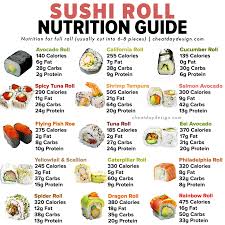
The bottom line
Sushi is a beloved Japanese dish that combines raw and cooked seafood, vegetables, rice, and seaweed. Traditional Japanese sushi is typically simple, containing only a few fresh ingredients and is naturally low in calories. However, many modern sushi variations can be higher in calories due to the addition of high-fat ingredients such as mayonnaise, cream cheese, or tempura batter.
When it comes to calorie content, sushi generally ranges from 93 to 190 calories per 100 grams, which typically equals 2 to 3 pieces. Vegetarian sushi, rice-free options, and non-fried sushi are often the lower-calorie choices, making them great options for those seeking a lighter meal.
While calories and fat content are important to consider, don’t forget to monitor the sodium levels in your sushi. Soy sauce and other salty condiments can contribute significantly to your daily sodium intake, so it’s important to be mindful and stay within the recommended limits for optimal heart health and overall wellness.
By selecting healthier sushi options, you can enjoy this delicious dish without compromising your nutritional goals.



